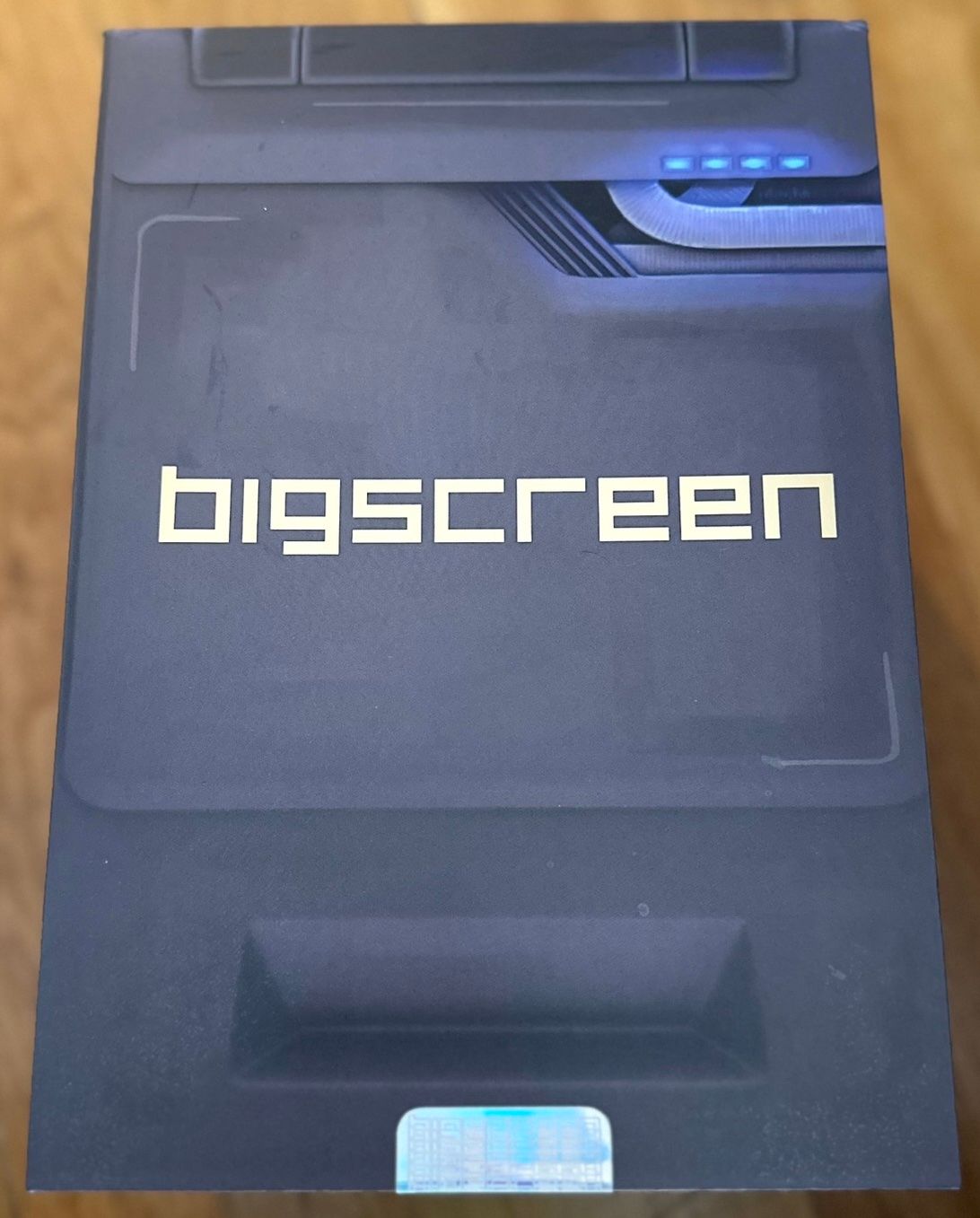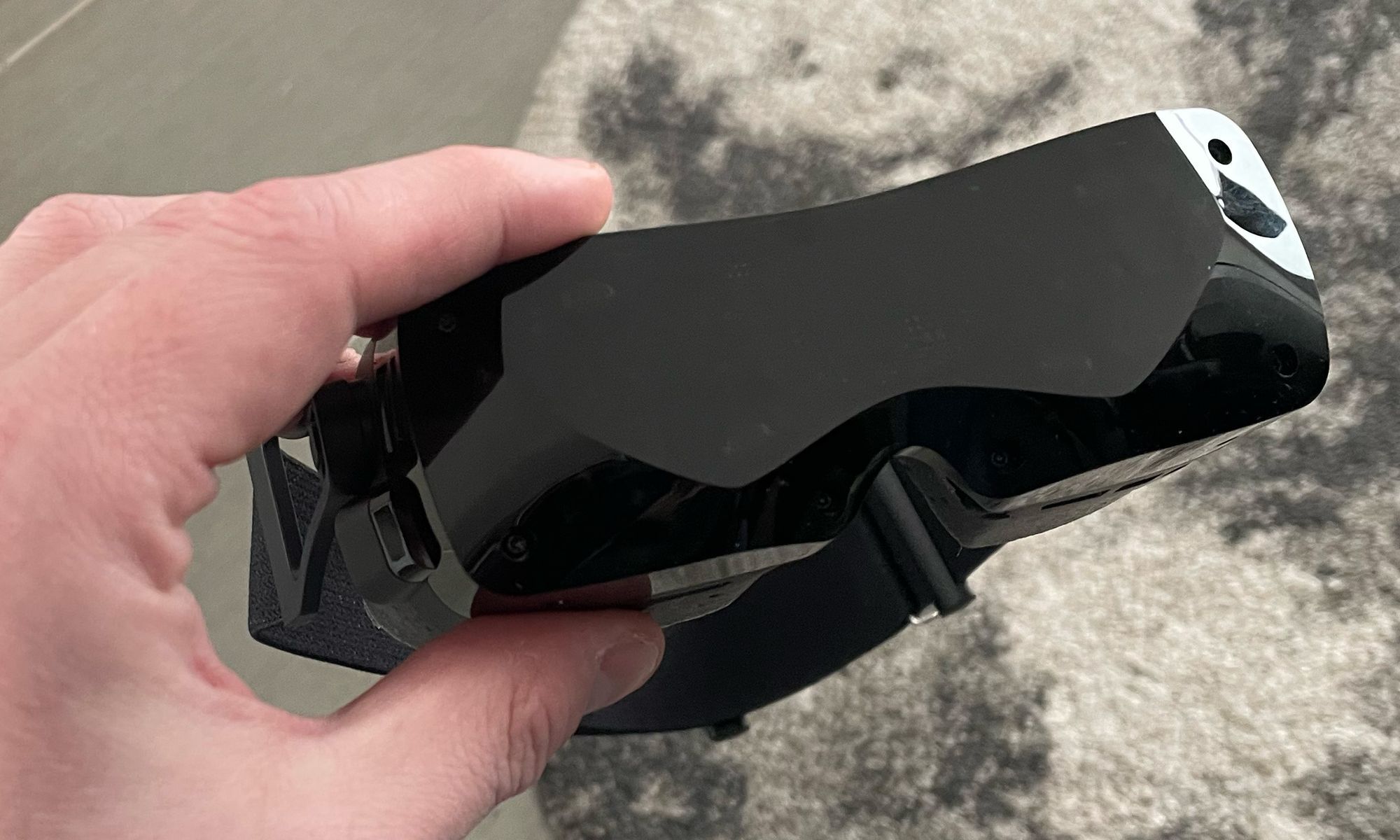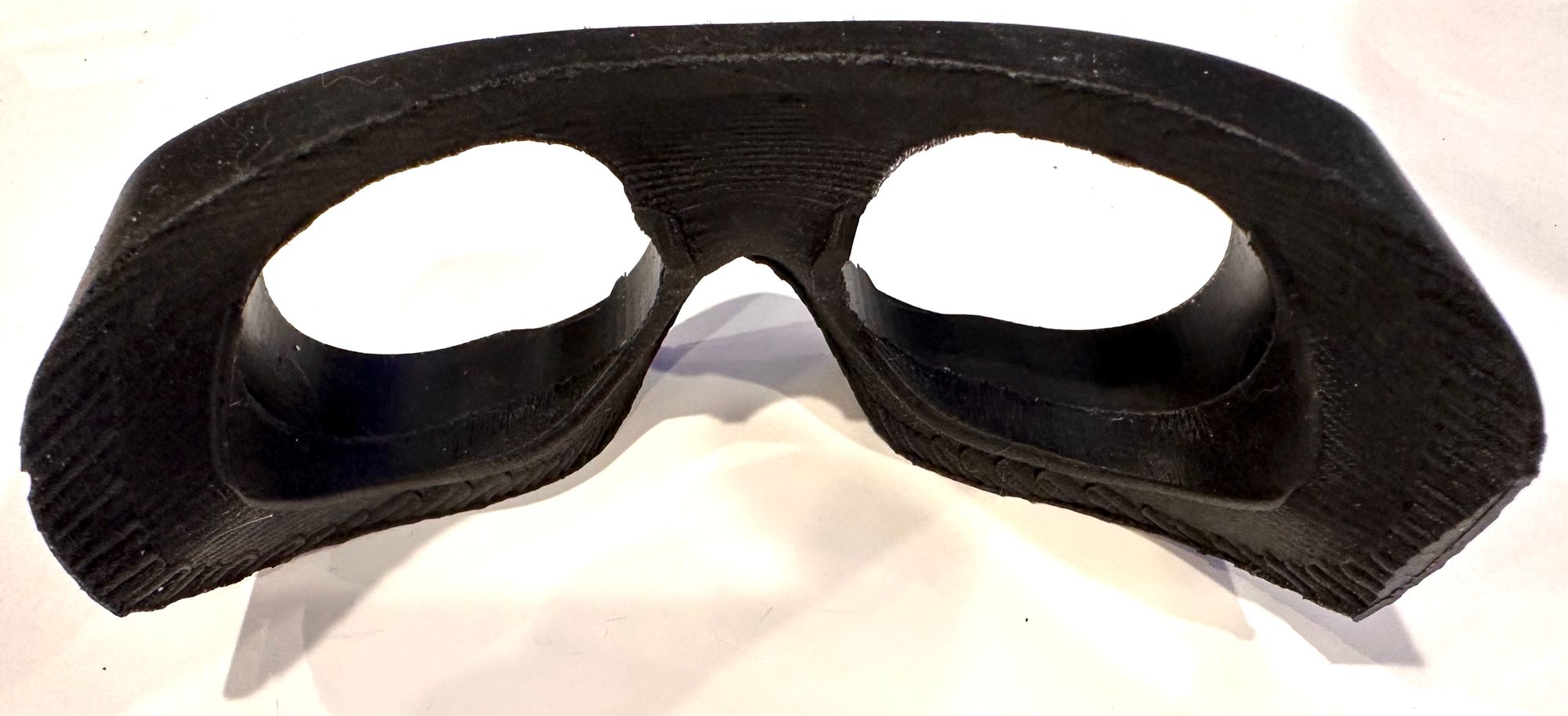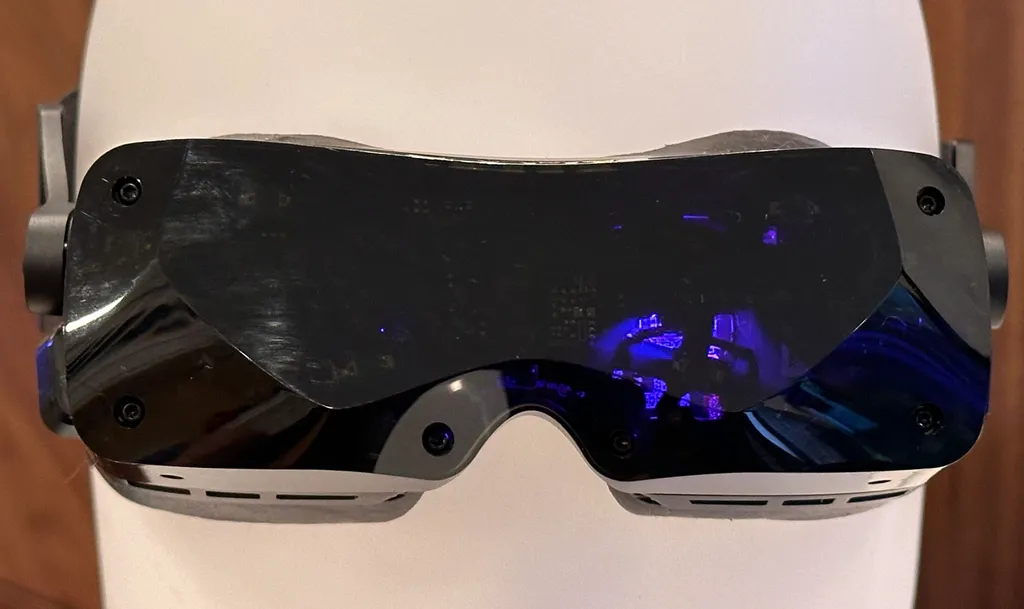Bigscreen Beyond represents a bold statement from a small software company making hardware for the first time. Beyond makes major design trade-offs in pursuit of delivering the world’s lightest fully-featured VR system. Here’s our review-in-progress assessment of this super slim PC VR headset powered by SteamVR Tracking.
I decided I wanted popcorn and a drink about 20 minutes into watching a movie which stretched out on a gigantic screen reflecting light onto the tops of the seats in front of me. A few minutes later, I dropped back into my comfy seat and started shoveling the popcorn in as the movie continued. I unscrewed the cap on a soda bottle, tilted it up and took big gulps as I watched some Avatar: The Way Of Water in 2D alone. Then I went into another room and watched some Eddie Murphy Raw with others in the seats in front of me.
I enjoyed movies and TV like this for hours in Bigscreen Beyond, and I also enjoyed playing Walkabout Mini Golf, Beat Saber, and Half-Life: Alyx with the headset enough that I can see Beyond becoming my go-to PC VR headset. While virtual movie theaters work on practically all VR headsets, and I’ve enjoyed traditional cinematic content in VR from time to time, Beyond’s weight loss helps make space for these kinds of experiences in a refreshing new way.
Yes, Beyond solves VR’s face-brick problem — but that doesn’t mean it offers the best visuals in VR right now or that it’s the right PC VR headset for you. Here’s a breakdown of what the new underdog of the VR market gets right, what it gets wrong, and who might want to think about adding Bigscreen Beyond to their home.
Why Is This A Review-In-Progress?
We’re posting this initial review as an in-progress assessment of Bigscreen Beyond before the company is shipping its add-on audio strap solution. While the headset includes stereo microphones, the upcoming accessory is expected to ship “late Q4” 2023 for $100. This accessory will pair built-in audio output with a more rigid strap. Initial testing was conducted using the soft strap and external stereo speakers to evaluate Beyond’s key trade-off — weight reduction — without any more grams on my head than necessary.
In addition, prescription correction matters a great deal and Beyond was tested without it. The lenses are sold for $79 and their absence in our testing makes it difficult to convey exactly how much physical relief one might expect with just Beyond’s approximately 127 grams grams on your head. This is still a fixed focus design, after all, and taking Beyond off and focusing on the real world again is a taxing transition for the eyes. A dull ache across my head will set in across my time in heavier headsets and that’s non-existent with Beyond. Instead, when Beyond’s cushion leaves my cheek there's relief at letting my skin breathe accompanied by a transitional period when my eyes take time to focus naturally again.
Given that Beyond is positioned as a premium product that’s custom-fitted for a single person and geared toward satisfying their most-demanding PC gaming needs, we think Beyond needs to be assessed further with additional accessories to provide more robust buying recommendations.
What Is Bigscreen Beyond?

Bigscreen Beyond is a high-end wired PC VR headset that sells for $1000 and requires a face scan from a phone for proper fitting.
Beyond’s optical system is driven by a pair of 1-inch 2560x2560 per eye microOLED displays which have 75Hz or 90Hz modes. The company lists the PC requirements as at least an NVIDIA RTX 2070 or AMD RX 5700 XT with DisplayPort 1.4 and DSC. The CPU should be at least a quad core Intel or AMD, and you’ll need two USB 3.0 ports.

Inside Beyond’s box is the visor, the custom shaped soft face cushion which magnetically snaps into it, a soft adjustable strap that clips onto each side, and the 5 meter cord which splits from a small box at the far end into a DisplayPort connector and two USB-A plugs.

At the other end, a single USB-C port carries VR through the visor’s left side. A second USB-C port on the right side of the headset can connect accessories like a USB-C to 3.5 mm headphone dongle for a simple wired audio solution.
Who Is Bigscreen Beyond For?
If what comes in Bigscreen Beyond’s tiny box is all you need to upgrade your PC VR gaming experience from a Valve Index or Vive Pro, then you might be in the market for this headset. If you don’t own SteamVR Tracking base stations, though, or don’t have a high-powered PC then it is hard to recommend Bigscreen Beyond as an entry point to the VR market right now.
That’s partially because if you’re buying into VR for the first time there are solid standalone headsets like a Pico or Quest that offer a much easier and less expensive path to your first VR game. Standalone headsets can also convert to PC VR headsets with built in streaming modes or apps like Virtual Desktop and, given that they’re not custom fitted, any friends or family that want to try out VR in your home alongside you will be able to give it a go with or without your PC engaged in the process.
That means if you get a standalone headset to drive your first PC VR experiences and decide to upgrade to Beyond later, this path also lets you easily spin up a multiplayer VR session via two headsets with one person playing in standalone and the other playing in Beyond on PC.
Even if you think sharing Beyond with others is unlikely, having a VR headset in your home is like a magnet for conversation and demonstration. Plus, Beyond looks way more inviting sitting out on a display stand than any other headset I’ve had. It's just that Beyond is not a headset you can put on another person unless their eyes are so similar to yours you could essentially exchange prescription glasses. Bigscreen says it comes in 18 sizes fitting interpupillary distances ranging from 58 mm to 72 mm, and moving the headset’s position on your face even the slightest amount can knock off the alignment with the displays such that VR becomes unplayable. The takeaway is that a poorly fitted Bigscreen Beyond can leave you with actual sore eyes or a headache after just a few seconds.
No, Beyond is not for sharing, and as of this writing it’s not ideal for first timers given the expense and setup involved in acquiring SteamVR Tracking base stations and compatible controllers like the Valve Index controllers or original Vive wands. Instead, it’s a lot easier to get into VR with another headset first and then think of Beyond as a treat-yourself deep-dive upgrade that demotes your old headset to the Mad Catz controller you pawn off on an unfortunate player two.
If you’re looking for a headset that feels great to wear for longer periods than pretty much every other headset on the market, it is certainly a straightforward path to go from a standalone headset to Beyond. There really is nothing else like Beyond on the market in 2023, so I can understand anyone with a bit of disposable income and a taste for the bleeding edge sitting reading this in one window with their finger hovering over the pre-order button on Bigscreenvr.com in another window.
Trade-Offs And Beyond’s Big Weakness
Yes, Beyond does indeed deliver multi-hour gameplay more comfortably than other headsets in one key dimension — weight. The biggest reason why I would still steer discerning buyers away from this as a first-time headset, however, is due to some distracting features of Beyond’s lenses.
A ring on the outside edge of the lenses features distracting distortions and blurring. I’d estimate, very roughly, the ring comprises maybe 10 percent the total field of view of the optics. Meanwhile, the lenses Meta introduced on Quest Pro remain the market leader in edge to edge clarity. I’d prefer Meta’s clearer lenses for general purpose VR usage with content that’s ideally experienced in, say, 30 minute to hour-long chunks. Going into VR for an hour or two though? Then I’d think about going in Beyond first, but not without battling with myself.
That’s because Beyond’s lenses also catch internal reflections in high contrast scenes. In the scene I described at the outset of this writeup, for instance, there were reflections flickering believably along the seats in the bottom-third of my vision, but mixed in next to them were unnatural reflections as well where bright areas of the theater screen were caught by the lenses in ghostly ways that scream “this isn’t a real theater”. Altogether, this means the sweet spot of maximum clarity at the center of Beyond’s optics are wide enough to center a large-format cinema screen in the sweet spot — exactly the use case Bigscreen is ideal for. So you can watch a movie or TV show stretching out in front of you with minimal distortion across the entire width of the landscape frame. Anytime your eyes wander away from the frame, however, you’ll be reminded by the lenses’ distracting imperfections that you’re not actually in a real theater.
We also experienced a loud buzzing noise from time-to-time caused by Beyond’s fans. Bigscreen is aware of the issue and recommends resetting the magnetic face cushion to make it go away.
Conclusion
Since 2014, Bigcreen has been the underdog of the VR market as it independently chips away at the software experience of watching traditional movie and TV content with others in VR. It’s a core use case for headsets that tech giants like Meta and Apple are throwing untold resources at building out and dominating. Bigscreen, meanwhile, has been operating with a fraction of the tech giants funding and is now shipping hardware that makes bold choices toward comfort-driven personalization rather than mass market share.
Supporting the underdog is hardly a compelling reason to spend $1000 on an imperfect first hardware offering from a startup. Still, it’s worth recognizing the role Bigscreen is playing in pushing back at Apple’s luxury-first approach or Meta’s effort to expand the market for its products by lowering the minimum age for use.
Bigscreen Beyond is made by VR enthusiasts for VR enthusiasts and, even imperfect, its existence provides a tantalizing tease of the future. Bigscreen has shown it can continue to iterate and improve its product over time, and its trade-offs should at the very least have your interest even if you’re not ready to give the company your dollars just yet.






























